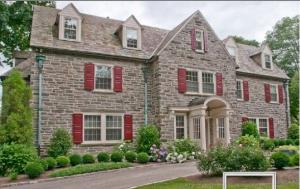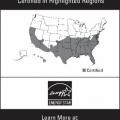Scope
When installing exterior storm windows,
- Choose models that are certified by ENERGY STAR.
- Choose models that are certified by the Attachments Energy Rating Council (AERC).
- Install according to manufacturers’ instructions.
See the Compliance Tab for links to related codes and standards and voluntary federal energy-efficiency program requirements.
Description
Modern storm windows include new energy-efficient technology and sleek design features that provide an easy-to-install, cost-effective method for upgrading the energy efficiency of existing windows, while offering additional benefits such as improved thermal comfort and better sound control (Figure 1). Unlike our grandmother’s old storm windows that had to be removed, stored, and replaced seasonally, modern storm windows are designed to be permanently installed and remain in place year-round. They come in both operable and fixed versions. Traditionally, storm windows have been single glazed with clear glass, but in recent years, many models have become available with low-emissivity (low-E) coatings, which significantly improve the thermal performance of the window. Low-E glass has a durable transparent silver coating that reduces energy loss through the window by reflecting the radiant heat back into the home. Coatings can also reduce the amount of solar heat gain, reducing cooling loads in summer. Tight-fitting modern storm windows also provide energy savings by helping to reduce the overall air leakage of the window. Low-E storm windows cost about the same as standard storm windows but are about 50% more energy efficient than traditional uncoated storm windows (Cort 2013).

For these reasons, the U.S. Environmental Protection Agency (EPA) now recognizes low-E storm windows in its ENERGY STAR® Program (Figure 2). Information on ENERGY STAR certified storm window products may be found on the ENERGY STAR Certified Storm Windows webpage.
The Attachments Energy Rating Council (AERC) (Figure 3) also provides information, certified ratings, and labeling for energy-efficient storm windows and other window attachments. See the Attachments Energy Rating Council website.
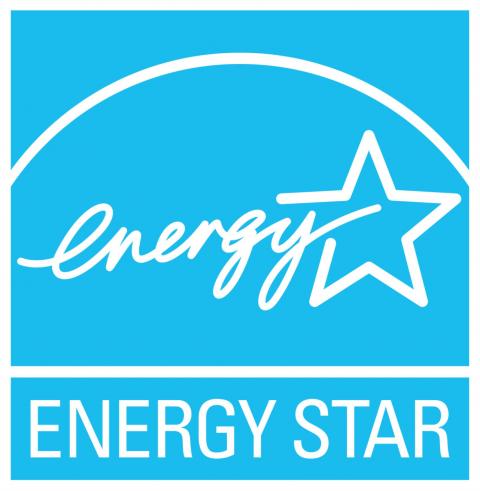

Benefits of Installing Exterior Low-E Storm Windows
Exterior low-E storm windows provide many benefits include the following:
- Interior appearance of the window is maintained, although the exterior appearance will change as the framing will appear slightly wider (Figure 1).
- The addition of exterior storm windows is typically acceptable for most historic preservation projects (Figure 4).
- Many frame colors are available, including the option for custom color matching (Figure 5).
- Installed storm windows are removable, an important consideration for historic preservation projects (Figure 6).
- Low-E storms can significantly improve the energy performance of the home by reducing air infiltration, thermal conductance, and solar heat gain through the assemblies (Figure 7).
- Low-E storm windows will reduce the potential for interior condensation on windows. There may be some risk of interstitial condensation between the original window and the exterior storm (but this is generally a temporary aesthetic concern, as opposed to a durability concern).
- The cost is low to moderate depending on the system chosen.
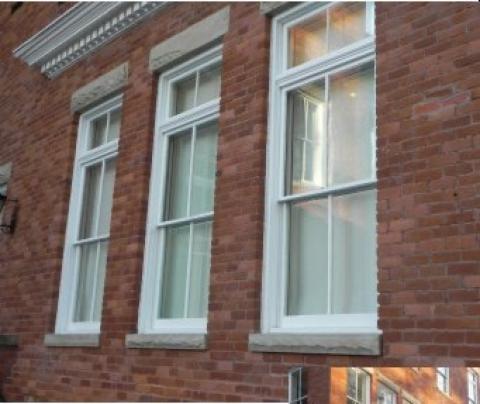
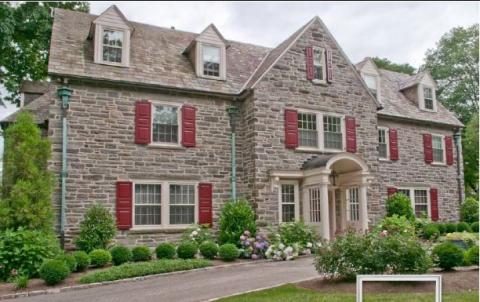

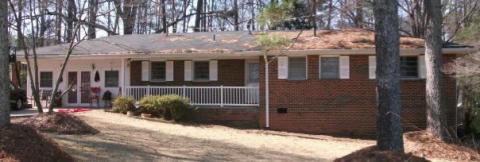
Installation of Low-E Storm Windows
Installing an exterior low-E storm window is a simple project and the labor, time, cost, and waste is considerably reduced compared to a full window replacement. If the existing window is in good shape, the installation of an exterior low-E storm window is quick and easy, requiring only simple tools and less than about 20 minutes of time (Figure 8). It can be a do-it-yourself task, although contractor installation may be advised, especially for upper-story installations. The existing windowsill must be in good condition, as it will continue to be exposed to the elements (although exposure will be significantly reduced).
The exterior storm window is fastened to the outer window casing, or in some cases directly to the window trim. The storm window should be sealed with an exterior-grade sealant at the jambs and heads, but left unsealed at the sill, then screwed into place in accordance with the manufacturer’s instructions. Most storm windows have an adjustable bottom leg to account for variations in the sill height. Exterior storm windows include small weep holes or notches in the bottom leg (Figure 9); these should not be caulked as they are included to provide drainage. Windows with weep drainage openings are recommended and are required for ENERGY STAR® certified products.
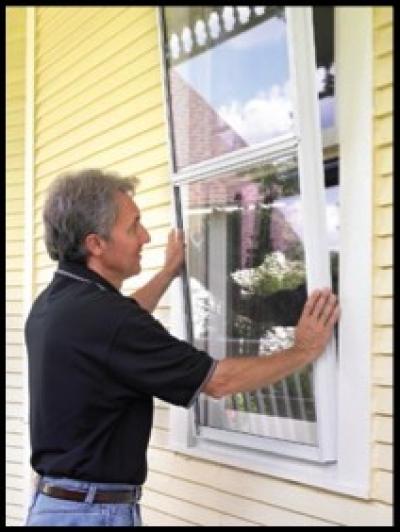

Reducing the Potential for Condensation
In order to minimize the potential for interstitial condensation, the original window must be made as air tight as possible (Wilson 1960). Slight ventilation of the exterior storm is typically provided by the weep holes provided at the sill. If the interior window is made sufficiently airtight, then the slight ventilation of the weep holes of the storm window should provide adequate air change to prevent condensation while also maintaining the improved thermal performance.
If condensation does appear on the storm windows, take the following steps:
- Make sure the weep holes are clear.
- Slightly increase the openings to allow for additional ventilation.
If condensation persists as an ongoing problem, consider the following additional steps to control indoor sources of humidity:
- Add timers or humidity sensors to bath exhaust fans and advise occupants to run exhaust fans when showering or cooking.
- Dry clothes outside or in the dryer; hang-drying clothes indoors adds a considerable amount of moisture to the indoor air.
- Ensure that the exhaust fans and clothes dryer duct outside, not into the attic or crawlspace.
- Verify that the crawlspace floor is covered with a continuous vapor barrier that covers the entire floor and is secured to the walls and that the sump pump basin is covered with a tight-fitting lid. Or, address any basement moisture issues.
- Run a dehumidifier if needed.
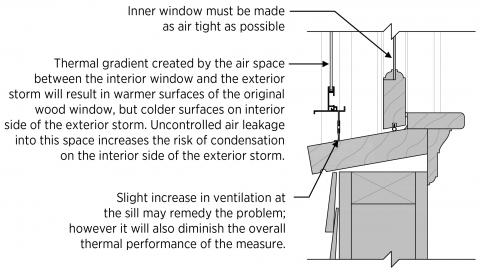
How to Install Exterior Low-E Storm Windows
- Determine the ENERGY STAR climate zone of the house.
- Select a storm window that is ENERGY STAR rated for your climate zone. The ENERGY STAR Product Finder can filter rated products by climate zone and other criteria.
- Inspect and repair or replace original window, sills, and/or weather stripping, if damaged or missing.
- Follow manufacturer’s installation instructions, typically:
- Ensure proper size and fit in accordance with the manufacturer’s measurement guidelines.
- Match current opening style of window to ensure operability and egress if desired or required.
- Apply exterior-grade caulk or sealant to the existing window frame where the sides and top of the storm window will be mounted. Do NOT caulk the bottom, in order to not block the weep holes and drainage gap in the new storm windows.
- Mount and screw the storm window into place.
5. If the low-E storm window is being installed onto a metal-framed existing window, care should be taken to include a “thermal break” between the storm window and existing window frames. This is simply a nonmetal separation such as a wood stop, rubber gasket, or even an air separation to minimize direct metal-to-metal contact and thermal conductance.
For more information, see the video “Interior and Exterior Low-E Storm Window Installation."
Success
Prior to considering exterior low-E storm windows, examine the condition of the existing windows. Replace or repair broken panes, broken hardware, and missing weather stripping. If the existing window shows excessive deterioration or frame rot, then full window replacement may be required. Additionally, the condition of the windowsill is critical to water management and to avoid water intrusion. Cracked or rotting sills need to be replaced prior to any installations being done.
To reduce the potential for interstitial condensation, the ability for warm moist air to travel from the interior to the exterior should be minimized by making the existing window as airtight as possible. Examine seals and weather stripping around the window perimeter and sashes for deterioration, and replace or repair as needed.
When selecting low-E storm windows, choose configurations and operator types (vertical slider, horizontal slider, fixed) that match the original windows (e.g., fixed over fixed, vertical slider over vertical slider, etc.) if the ability to open the windows is desired or required for egress by code.
Climate
Historically, storm windows have been used in colder northern climates, but energy savings have also been demonstrated across most of the United States, including more moderate regions with a mix of heating and cooling needs. The ENERGY STAR® program for Exterior and Interior Storm Windows certifies low-E storm windows for both northern and southern regions (Figures 1 and 2), where the primary difference is the type of low-E glass. All low-E glass is more insulating than normal glass, but different options are available. Most low-E storm windows use clear low-E glass with a high solar transmittance that does not block sunlight. This is particularly beneficial in central and northern regions, when the sun’s warmth is allowed to help offset the heating needs of the home. For southern regions or other applications where cooling is of more concern than heating, the ENERGY STAR® program requires the low-E glass to have a lower solar transmittance. This solar control low-E is still insulating, but also blocks more of the sun to reduce the cooling needs in the home. It should be noted that both types of low-E glass save energy in all regions, but choosing the type in accordance with ENERGY STAR® guidelines for your region will optimize energy performance and improve resistance to extreme heat or extreme cold. To determine whether your location falls in the northern or southern rating category, see the ENERGY STAR climate zone webpage.
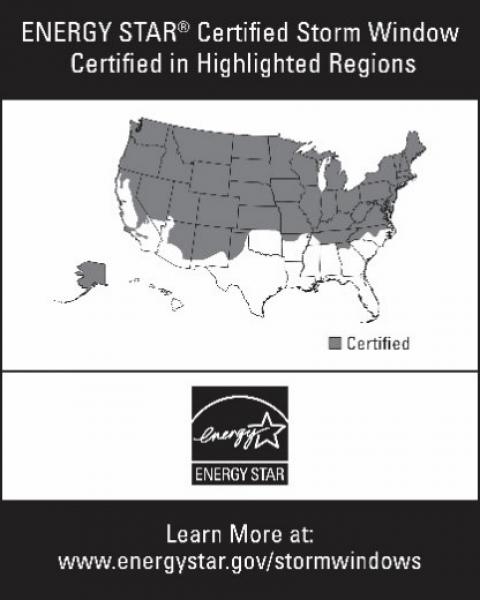
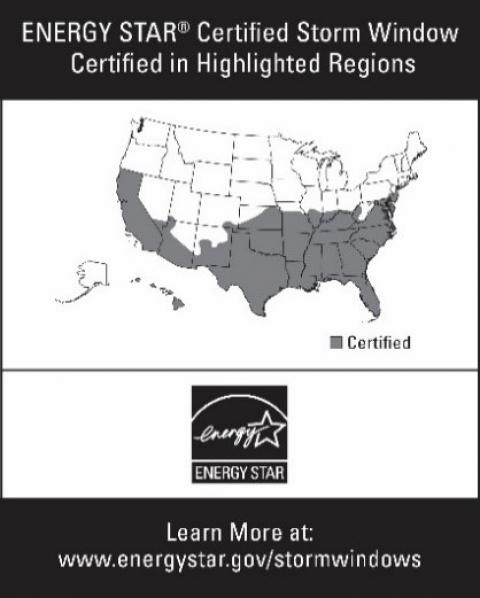
The Attachments Energy Rating Council (AERC) also provides information and certified ratings on the energy performance of storm windows in both cool and warm climates (heating dominated and cooling dominated). This allows the consumer to select the product performance most beneficial to them, based on both geography and their specific circumstances (See Figure 3).

There are also climate differences regarding the potential for interstitial condensation to form between the storm window and the existing window. As noted on the Description tab, interstitial condensation is generally more of a temporary aesthetic concern rather than a durability or performance concern. It only forms under certain conditions when warm moist air from the interior of the home leaks through the existing window and reaches a cold storm window surface. Making the existing window as airtight a possible, as well as reducing any sources of excess moisture and humidity in the home will reduce the potential for formation of condensation. Condensation is unlikely to form in warmer regions and summer seasons because the temperature is warmer and above the dew point. In cold regions, condensation or ice is less likely to form during the deep winter season because humidity levels in winter air are typically very low, unless there are moisture issues in the home. Condensation formation is more often seen in the shoulder seasons of fall and spring when the outside temperature is cool but there is still sufficient moisture in the air. This condition is usually temporary and resolves on its own as the day warms, especially if there is sun exposure on the window.
Training
CAD
Compliance
Retrofit
Storm windows are typically installed by the homeowner as a retrofit measure. The information provided in this guide on the Scope and Description tabs applies to existing as well as new homes. As noted elsewhere, inspect and repair or replace windows or broken panes, hardware, sill, trim, weather stripping etc., if needed, before installing the storm windows.
More
More Info.
Access to some references may require purchase from the publisher. While we continually update our database, links may have changed since posting. Please contact our webmaster if you find broken links.
The following authors and organizations contributed to the content in this Guide.
